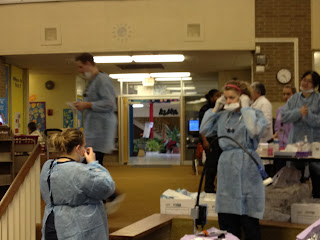So much can be
taken away from the sealants rotation. An obvious item is that the experience
allowed me to hone my hand skills as a clinician. I developed techniques to
help with fine hand movements while working in limited space. But beyond the
practical experience, this was a true opportunity to refine communication
skills. The locations that our rotations took place were prime venues for young
professionals to escape the comfort zone of the classroom and work with
patients who were in a completely different state of mind, in so many ways.
This program provided our class firsthand experience on working with inner-city
children from the Cleveland Metropolitan School District. It was a moving
experience that taught me how pivotal access to care can be in a community and
confirmed the necessity of subsidized programs such as this one.
Before
participating in sealants rotation, I believed that there was a large disparity
in oral health status between children from rural areas versus those located in
the inner city. I now know that this isn’t necessarily true. Although it’s the
year 2012, there were children that informed my partner and me that they did
not even own a toothbrush. This wasn’t as much an indication of low income but
more a shocking perspective of priorities in areas of low social economic
status (SES). I performed my own research before attending the rotation and made
note that in order for schools to be eligible for the sealants program at least
50% of the children must qualify for free or reduced cost lunch (185% below
federal poverty guidelines). Even this knowledge was not enough to prepare me
for some of the mouths that I would work on. There were many children with caries; some
required urgent care and to my surprise didn’t register any discomfort during
probing. It is one thing to hear statistics and another to see it.
There was one
particular patient interaction that had an impact on me. Following our normal
routine in the final week, my partner and I set up our station and grabbed a
new patient. It was my turn to play doctor and I introduced myself to a very
sweet second grader and asked her to take a seat for an examination. After
opening her tiny mouth, it was immediately apparent that she had rampant decay
in her adult molars, the worst I’d seen by far. I thought to myself, how could
this already occur at such a young age?? So I asked her, “How often do you
brush your teeth, Sweetie?” to which she responded, “I don’t have a
toothbrush”. She informed me that none of her siblings owned a toothbrush; my
heart broke for her family. There were some portions of her molars that were
salvageable for placing sealants but this gesture would not be enough to save
this poor child’s mouth in the long run if there weren’t serious changes at
home.
In
the beginning of last semester we watched a movie called, Unnatural Causes.
This movie did an excellent job describing the hardships faced by families of
extremely low social economic status, and displayed obvious marketing schemes
that continue to suppress these areas. There was a period in my childhood where
my dad was a single parent with no choice but to raise my sister and me, in a
flea ridden apartment in a low SES community full of corner stores and run down
businesses. I felt for these children, but I wanted to do my best to convey to
them that there are people out there that want to help them be healthy and
successful.
Despite the
difficult moments, I gained invaluable experiences. There were some children
who had excellent oral hygiene to which I could only do my job and send them
off without a care in the world. I enjoyed the challenge of working with these
disadvantaged elementary students. For me, it wasn’t an issue of relating to
their lives but more developing my communication skills with children. I am
thankful to have participated in this program.



























No comments:
Post a Comment